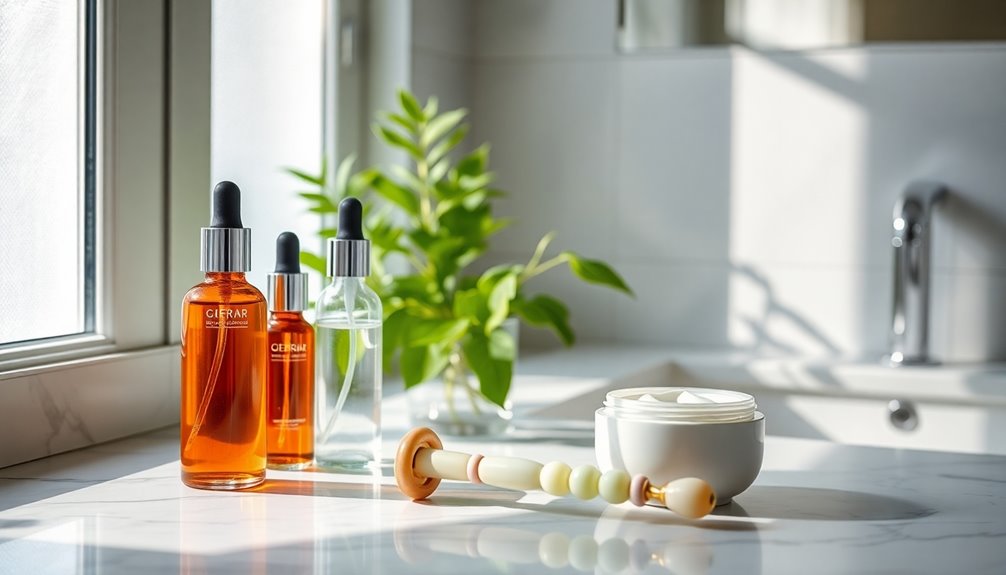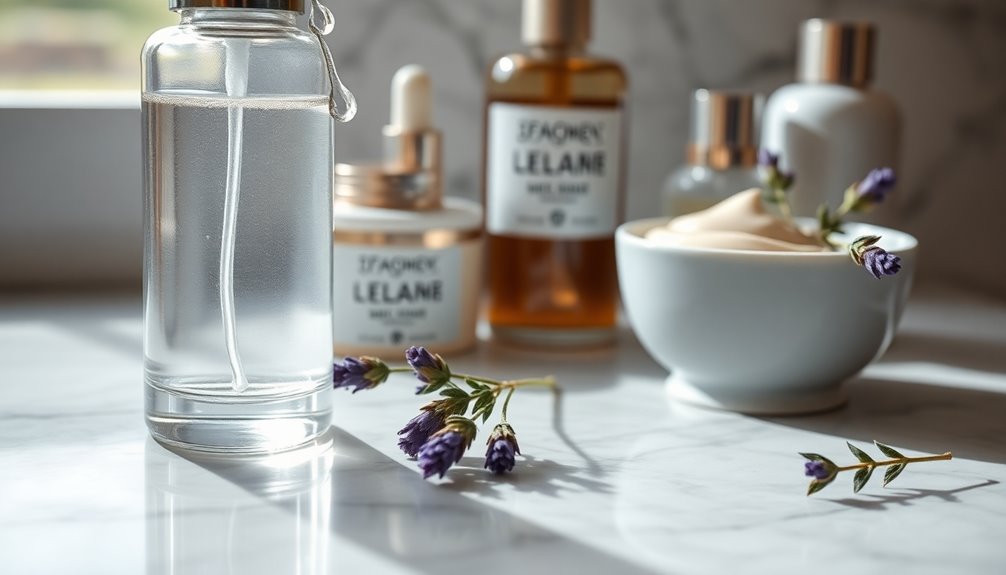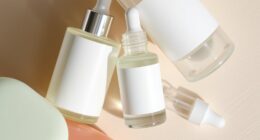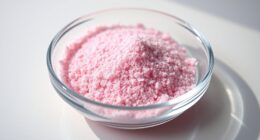You should apply serums before moisturizers. Serums have smaller molecules that penetrate deeper into your skin, delivering concentrated active ingredients more effectively. By applying moisturizer afterward, you lock in those benefits and create a protective barrier to prevent moisture loss. It's essential to allow the serum to absorb for a few minutes before following with your moisturizer. Want to understand the best techniques and product combinations for your skincare routine? There's plenty more to explore!
Key Takeaways
- Apply serums before moisturizers to ensure deeper penetration of active ingredients into the skin.
- Moisturizers create a barrier that locks in the benefits of the serum, preventing moisture loss.
- For best results, apply serum on slightly damp skin to enhance absorption.
- Allow a few minutes for serum absorption before applying moisturizer for optimal efficacy.
- Always layer products from thinnest to thickest, starting with serums and ending with moisturizers.
Understanding Serums and Moisturizers

When it comes to skincare, understanding the roles of serums and moisturizers is essential for achieving healthy skin.
Serums, being water-based with smaller molecular structures, penetrate deeply to deliver concentrated active ingredients that target specific skin concerns. Additionally, using serums rich in antioxidants can further enhance your skin's protection against environmental damage.
Serums penetrate deeply with their water-based formulas, delivering potent active ingredients that effectively address specific skin concerns.
On the other hand, moisturizers contain oils that create a protective barrier on the skin, locking in moisture and preventing water loss. This barrier can impede serum absorption if applied first.
For ideal results, apply serums immediately after cleansing and toning, allowing those powerful active ingredients maximum contact with your skin.
Then, follow up with a moisturizer to seal in the benefits and provide overall hydration. Balancing these two products can greatly enhance your skincare routine and overall skin health. Additionally, using essential oils like lavender oil can help improve your skin's overall condition and promote relaxation during your skincare routine.
The Correct Order of Application

Establishing the correct order of application is essential for maximizing the effectiveness of your skincare routine.
Begin by cleansing and toning your skin, then apply serum. Remember, serums should always go on before moisturizers to guarantee they can absorb properly. This principle of layering is similar to the importance of dynamic communication exercises that enhance understanding between partners.
The correct order follows the principle of layering from thinnest to thickest; this allows the lighter serum to penetrate your skin effectively.
After applying serum, give it a few minutes to fully absorb. Once it's settled in, you can apply your moisturizer.
This creates a protective barrier that locks in the serum's active ingredients, preventing moisture loss and enhancing hydration. Additionally, using products with active ingredients can further improve skin health and hydration levels.
Sticking to this order not only improves efficiency but also leads to quicker, noticeable results.
Benefits of Applying Serum Before Moisturizer

Applying serum before moisturizer allows your skin to absorb the active ingredients more effectively, targeting specific concerns like dryness or dullness.
Since serums have smaller molecular structures, they penetrate deeply when applied to clean skin. This method not only enhances absorption but also sets the stage for your moisturizer to lock in those benefits. Additionally, certain serums may contain ingredients like glycolic acid that can further enhance skin texture and clarity. Moreover, using a hydrocolloid patch after applying serum can help treat any active blemishes while your skin absorbs the serum's benefits.
Enhanced Absorption of Ingredients
By applying serum before moisturizer, you can greatly enhance the absorption of its active ingredients. Serums typically have a smaller molecular structure than moisturizers, allowing them to penetrate deeper into your skin.
When you apply your products in this order, you'll enjoy several benefits:
- Maximized Contact: The serum gets more direct contact with your skin, boosting its effectiveness.
- Better Moisture Retention: Moisturizers lock in the serum's active ingredients, preventing moisture loss. This method is similar to how low-fat options can help manage overall health while enjoying treats like ice cream.
- Improved Skin Health: Consistent application can lead to healthier skin and targeted treatments for concerns.
Additionally, maintaining proper hydration through effective hydration techniques is crucial for maximizing the benefits of both serums and moisturizers.
For best results, let the serum absorb for a few minutes before applying your moisturizer. This method guarantees enhanced absorption of ingredients, making your skin care routine more effective.
Targeted Skin Concerns Addressed
When you apply serum before moisturizer, you're not just enhancing absorption; you're also effectively targeting specific skin concerns.
Serums contain concentrated active ingredients that work best on clean skin, allowing them to penetrate deeper and address issues like acne, aging, or hyperpigmentation. By applying the serum first, you maximize its efficacy, ensuring it reaches the layers of skin where it's needed most. Additionally, essential oils can be incorporated into your routine to provide added benefits for targeted skin concerns.
The moisturizer then acts as a barrier, locking in those benefits and preventing moisture loss. This dual-layered approach not only hydrates but also delivers targeted treatments, making your skincare routine more effective. Additionally, using serums with glycolic acid can significantly improve skin texture and radiance.
Ultimately, using serum before moisturizer helps improve your skin's health and appearance, giving you the results you desire without interference from heavier products.
Importance of Skin Preparation

To get the most out of your serums, proper skin preparation is key.
Start by choosing the right cleanser to remove impurities, then apply your serum on slightly damp skin to boost absorption.
This simple step can greatly enhance the effectiveness of the products you're using.
Damp Skin Benefits
Applying skincare products on damp skin can greatly boost their effectiveness, as it helps lock in moisture and enhances absorption.
When your skin is slightly damp, both moisturizers and hydrating serums can penetrate better, maximizing their benefits.
Here are three key reasons to embrace this technique:
- Improved Hydration: Damp skin traps moisture, allowing your moisturizers to work more effectively.
- Enhanced Absorption: Serums applied on damp skin can deliver active ingredients deeper into your skin.
- Optimized Routine: Lightly misting your skin after cleansing guarantees it's perfectly damp for your products, enhancing hydration.
Cleanser Selection Matters
Selecting the right cleanser is essential for healthy skin preparation. A gentle cleanser designed for your skin's microbiome helps maintain moisture retention and supports skin hydration. When you cleanse properly, you remove makeup and impurities, optimizing your skin for serum application. Avoid harsh bar soaps and body washes, as they can strip crucial oils and disrupt your skin's barrier.
| Cleanser Type | Benefits | Considerations |
|---|---|---|
| Gel Cleanser | Lightweight, great for oily | May not suit dry skin |
| Cream Cleanser | Hydrating, gentle on skin | Can be too heavy for oily |
| Micellar Water | Quick and effective | May require follow-up cleanse |
Choose wisely, and your skin will thank you!
Timing for Active Ingredients

When should you apply active ingredients for the best results? The timing for active ingredients in your skincare routine is essential for maximizing their effectiveness. Here are some tips to guide you:
The timing of active ingredients in your skincare routine is crucial for achieving optimal results.
- Morning Routine: Apply Vitamin C serums to brighten your skin and protect against free radicals.
- Evening Routine: Use retinoids and exfoliating products at night, as they can increase sun sensitivity and may irritate skin when exposed to sunlight.
- Wait Time: Allow serums to fully penetrate for a few minutes before applying your moisturizer, ensuring ideal absorption.
Common Misconceptions About Product Order

Though many people think the order of applying skincare products doesn't matter, common misconceptions can lead to less effective results.
For instance, it's a myth that you should apply moisturizers before serums. In reality, serums are designed to penetrate deeper, so they should always go on first to maximize absorption.
Many also believe thicker products enhance absorption when, in fact, thinner serums should precede thicker moisturizers.
Skipping serums altogether is another mistake; they target specific concerns and boost your moisturizer's effectiveness.
Finally, remember that layering products without considering product order can hinder how well active ingredients are absorbed into your skin.
Understanding these misconceptions can improve your skincare routine and overall results.
How to Layer Products Effectively

To achieve the best results from your skincare routine, it's crucial to layer products effectively.
Effective layering of skincare products is essential for optimal results in your routine.
Start by applying serums after cleansing and toning, as they've smaller molecular structures that penetrate deeper into your skin.
Follow these steps to maximize absorption and hydration:
- Apply serums: Use lightweight serums on damp skin to help draw moisture into the deeper layers.
- Wait a few minutes: Allow the serums to fully absorb before moving to the next step.
- Seal with moisturizers: Finally, apply moisturizers to lock in the active ingredients and create a protective barrier.
Recommended Serum and Moisturizer Combinations

Selecting the right serum and moisturizer combination can greatly enhance your skincare routine.
For daytime, try pairing an Intensive Nourishing Facial Oil with Green Tea EGCG Concentrate Cream; this duo boosts hydration and antioxidant protection.
At night, combine a Multi-Vitamin + Antioxidants PM Facial Oil with a Multi-Vitamin + Antioxidants Cream for ideal nourishment and skin repair.
If you're looking for concentrated antioxidant benefits, use Super Fruit Facial Oil over Super Fruit Cream, suitable for both day and night.
For hydration, layer Rose Water Hydrating Milk followed by Organic Rosehip Oil.
Each of these combinations targets specific skin needs and enhances overall effectiveness, ensuring your skincare products work synergistically.
Don't forget to take into account adding hyaluronic acid for extra moisture!
Personalizing Your Skincare Routine

Personalizing your skincare routine is essential for achieving the best results, as it allows you to choose products that directly address your unique skin type and concerns.
To create an effective routine, follow these steps:
- Identify Your Skin Type: Determine whether your skin is oily, dry, combination, or sensitive to select the best serum.
- Choose the Right Order: Apply serums before moisturizers to maximize absorption of active ingredients.
- Monitor and Adjust: Regularly evaluate your skin's response and adjust products as needed, such as adding hydrating serums or changing moisturizers.
Don't hesitate to consult with a dermatologist for personalized recommendations.
Consistency is key; sticking to a routine tailored to your skin's needs can greatly enhance your overall skin health.
Frequently Asked Questions
Should You Apply Serum Before or After Moisturizer?
You should apply serum before moisturizer. This order allows your skin to absorb the serum's active ingredients effectively.
After cleansing and toning, use your serum on damp skin for better absorption. Wait a few minutes for it to fully sink in, then follow up with your moisturizer.
This layering technique not only enhances hydration but also locks in the benefits of the serum, giving your skin a healthy, radiant look.
Which Came First, Moisturizer or Serum?
When you think about which came first, moisturizer or serum, it's crucial to understand the order of application.
You should apply serums after cleansing and before moisturizer. This way, the serum can penetrate deeply and deliver its active ingredients effectively.
Following up with moisturizer helps lock in those benefits and keeps your skin hydrated.
Sticking to this routine guarantees you get the most out of your skincare products for healthier skin.
Do You Put Serum Before or After Dry?
Do you really want to miss out on your serum's full potential?
You should apply serum on clean, dry skin for the best absorption. If your skin's damp, it can enhance the serum's effects, but make certain it's not soaking wet.
Once you've let the serum soak in for a few minutes, you can lock in those benefits with a moisturizer. This order guarantees your skin gets the hydration it craves!
What Not to Do After Applying Serum?
After applying serum, avoid using heavy oils or occlusives right away, as they can block the serum's absorption.
Don't skip your moisturizer, since it helps lock in the serum's benefits.
Steer clear of applying other actives, like retinoids or exfoliants, too soon, as this can irritate your skin.
Finally, resist the urge to rub or massage your skin excessively, as it can disrupt the serum's effectiveness and absorption.
Conclusion
In the world of skincare, think of serums as the seeds you plant in your garden, while moisturizers act as the nourishing soil that helps them thrive. By applying serum first, you allow those potent ingredients to penetrate deeply, maximizing their benefits. Then, layer on your moisturizer to lock in hydration and protect your skin. So, embrace this order to cultivate a glowing complexion and watch your skin blossom beautifully!










